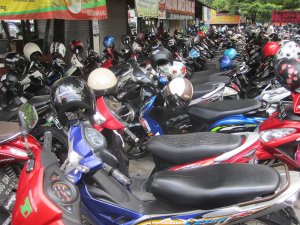People and motorbikes galore
Java is just over half the size of Great Britain (128K km2 vs. 230K km2), but packs twice the population of the UK into that space – that’s 145 million people on one island. So it’s not surprising that you see an awful lot of people wherever you go, especially in the cities.
There are a staggering number of motorbikes on the roads – it’s the main means by which people get around, accounting for 82% of all registered vehicles. The roads in Semarang and Jogyakarta are dominated by motorbikes, which dart in and out of the main traffic flow in the most alarming way. They come at you from all angles. Furthermore many of the bikes carry 2, 3 or 4 passengers – it’s not uncommon to see a Dad driving the bike, with Mum at the back, and two kids squeezed in between!
The rules of the road are not spelt out in a detailed highway code, and the ‘system’ is not entirely logical. Cars are right-hand drive, and people drive on the left as in the UK, but that is where the comparison finishes. This is how the system works on the many dual carriageways:
- the slow lane is the one nearest to the central reservation;
- most cars and lorries overtake on the left;
- but motorbikes stick together at the left hand side of the road.
- So when you overtake you accelerate towards the hundreds of motorbikes which are going slower than you… nice and safe!
- But when a car wants to turn left they have to slow down (in the overtaking lane) and wait for all the motorbikes to go past first, thus meaning everyone in the fast lane has to slow down and jam on the brakes.
I am not making this up by the way!!
On a normal two-lane main road cars overtake to either left or right of the car in front, sometimes on both sides at the same time…
 There aren’t many motorway grade roads, but where there are, you get a wonderful hybrid of driving styles, with some lorries grinding slowly in the left hand lane, and others sticking to the traditional slow lane on the right… anyone wanting to overtake just has to weave in and out of the slower-moving vehicles. When I queried why the system was like this, I just got a smile and a shrug of the shoulders: “That’s the way things work round here!”
There aren’t many motorway grade roads, but where there are, you get a wonderful hybrid of driving styles, with some lorries grinding slowly in the left hand lane, and others sticking to the traditional slow lane on the right… anyone wanting to overtake just has to weave in and out of the slower-moving vehicles. When I queried why the system was like this, I just got a smile and a shrug of the shoulders: “That’s the way things work round here!”
I have started to realise that this characteristic of ‘adaptive acceptance’ is a deep-seated trait in the Indonesian psyche… it’s quite difficult to cope with as a European, used to a culture in which we are encouraged to question and challenge everything!
 Everywhere you go, you see more people doing things than you would initially expect: hotels, shops and restaurants are more than generously staffed; state-owned bodies like the post office and railway have an army of people working for them. On my train journey from Kutoarjo to Jogya, at Kutoarjo station I counted 6 porters, 2 security officers, 3 train cleaners, 2 station toilet cleaners, 4 ticket agents, 3 ticket controllers, not to mention 2 customer service reps and 3 railway police! And this is not a big station like Jogya; only 4 trains passed through in an hour and a half.
Everywhere you go, you see more people doing things than you would initially expect: hotels, shops and restaurants are more than generously staffed; state-owned bodies like the post office and railway have an army of people working for them. On my train journey from Kutoarjo to Jogya, at Kutoarjo station I counted 6 porters, 2 security officers, 3 train cleaners, 2 station toilet cleaners, 4 ticket agents, 3 ticket controllers, not to mention 2 customer service reps and 3 railway police! And this is not a big station like Jogya; only 4 trains passed through in an hour and a half.
Another example: I went past a large ground-floor house on Sunday morning where a new floor and roof were being constructed. There seemed to be hundreds of people gathered round working on the project. I reckoned about thirty people stood on the ground level, mixing concrete and passing buckets to the bottom of a wide staircase. This had been purpose-built from bamboo and comprised about 12 steps. On each step there were at least 2 people passing the buckets of cement up one at a time to the next rung, so about 30 people were working on the staircase. Then another great bunch of people stood on top of the structure, moving the cement and bricks to their next destination.
Conclusion? Labour is cheap, and people are plentiful. It may not seem efficient by our standards, but in a strange way the job does get done. And anyway, who are we to judge?
